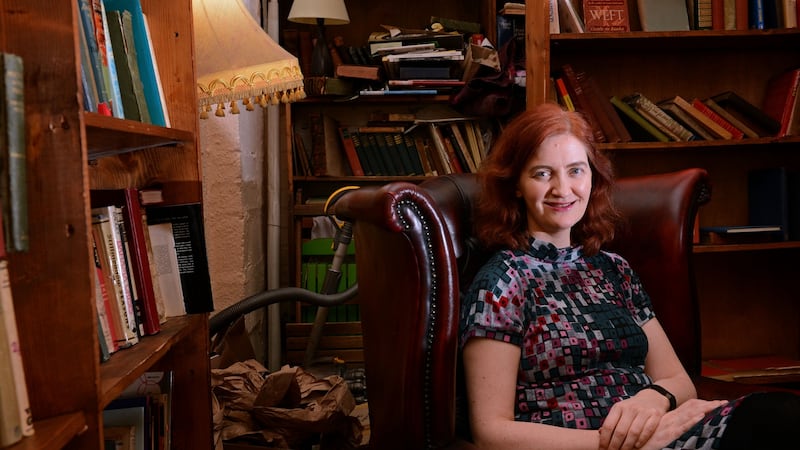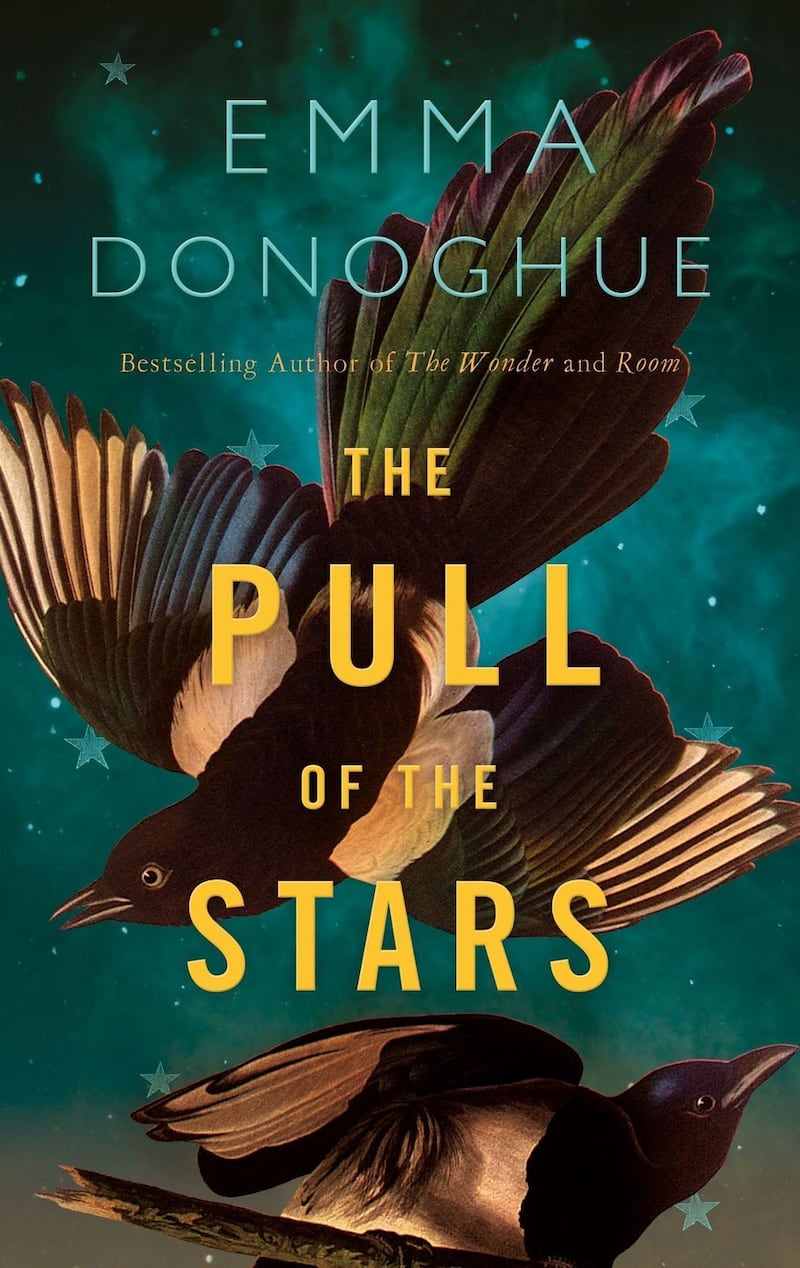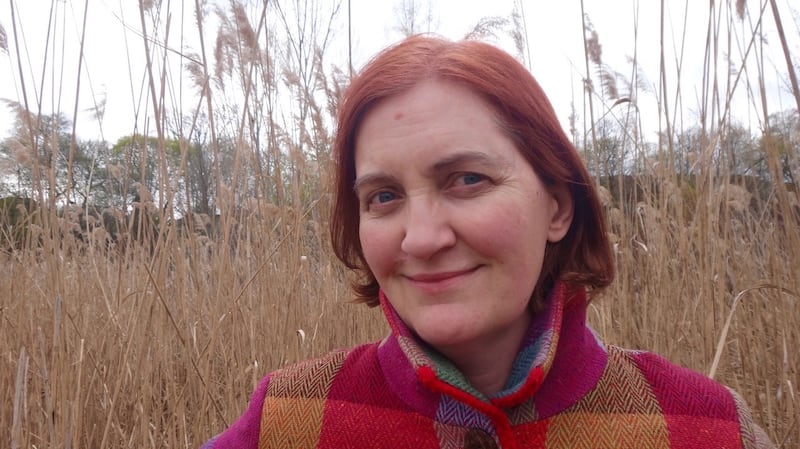Signs on public transport warning people to wash their hands. People wearing face masks, flinching from other people’s coughs. A capital city full of boarded up businesses and streets that look like the end of the world. Sound familiar? All these markers, and more, of the times we have been living through can be found in Emma Donoghue’s new novel, The Pull of The Stars, which, in a stroke of literary good fortune and intriguing coincidence, just happens to be set in Dublin in the middle of a pandemic.
“I know, I know,” laughs the prolific author of plays, children’s books and novels including Slammerkin, Room, and The Wonder. She’s is speaking from the home in Ontario, Canada that she shares with her partner Chris Roulston and their two teenagers, Finn and Una.
“I generally go out of my way not to be timely or to try and capture cultural moments. It’s very peculiar,” she says.
She is keen to point out that this was no shrewd career move on her part, but the happiest of accidents. She began writing the novel in October 2018, inspired by an article in The Economist marking the centenary of the Spanish flu. She sold the book last autumn, and delivered the final draft in March of this year. The publishers had intended to release it in early 2021 but when the coronavirus pandemic hit they decided to rush it out to capitalise on the novel’s unexpected pertinence.
“It’s funny, because you’re so used to literary fiction being slow moving and it’s kind of astonishing to see that it can move that fast,” she says . “It’s a very untypical experience because a lot of writers have had their publications delayed. So it feels very odd to be in this situation, benefiting from the crisis.”
She says she didn’t do any last-minute “tinkering” to the book in an effort to echo the current pandemic even more intensely. “Frankly I didn’t need to, it was already about that uniquely tense atmosphere, the confusions, the need to get on with everybody earning a living and yet having to shut things down in order to prevent death . . . all the looking around and thinking which way is my death coming for me?”
The book is set over three frenetic days in the Dublin of 1918, a time when the capital is in turmoil from both war and disease and government notices urge people to “eat more onions” as rumours fly about what might protect the population. “The government has the situation well in hand,” reads another notice. “If you feel yourself succumbing report yourself and lie down for a fortnight.”
The country is in the grip of “the grippe” – one of the many names for the terrible new flu that claimed millions of lives around the world. Nurse Julia Power is fighting her own battles in an understaffed hospital in the city centre. In a tiny ward called Maternity/Fever she is in charge of pregnant women who have contracted the illness. The other two main characters are real-life historical hero Dr Kathleen Lynn, and a young impoverished hospital volunteer Bridie Sweeney.

“One thing the article I’d read left me with was the fact that women in the last stages of pregnancy and a few weeks after birth were the most vulnerable to catching the flu and having terrible side effects. Luckily, that doesn’t seem to be true of Covid-19 but it was really true then, that flu and childbirth were a terrible combination.
“I thought it was so interesting to set a book during World War One but in this all-female, intense little world and to play up the notion of childbirth as women’s war. It goes on all the time and it’s still dangerous even today. And because it’s so common and because we all came from birth ourselves, it’s just seen as routine. So the most feminist decision I made was to choose to set the book in a maternity ward. All sorts of dramas were going on, but here’s the drama that is going on all the time.”
It’s this criss-crossing of fact and fiction and of the two storylines, a virulent flu pandemic and the minutae of childbirth, that makes the book so compelling. “I thought it would be great to look at how much pure drama and complexity could come out of those two medically complicated situations.”
There is, for one example, a long, excruciating scene where Julia helps a woman birth her baby, a scene so harrowing and detailed I had to put the novel down for a few minutes afterwards. This is close-quarters observation of women’s bodies as they go through the wars, a celebration of the kind of heroism that goes unrewarded with medals or crosses. You wince, reading about the young nurse’s grit and determination while excavating the remains of the afterbirth from her patient’s womb, while simultaneously applauding her warrior qualities.
I’ve read that Donoghue loves the research process behind many of her books, but how did she go about researching that? “I didn’t research it, I lived it,” she says laughing. “That’s the one bit of the book that’s autobiographical.”
She tells the story of a tree falling on her house when she was five weeks away from the due date with Finn, her first child, “and it kind of popped him out of me”.
Despite his sudden arrival, she describes it as an “excellent birth”.
“So here I am happy as a clam, you know, Chris weeping with happiness and then I noticed the midwife saying, um, ‘afterbirth not quite coming out’. I’m thinking, ‘oh who cares? I’m so happy. Surely that can happen at some later stage’. Next thing I know the door opens and this obstetrical surgeon rushes in and I’m like, ‘oh hi, Dr Hunter, here’s my lovely baby’ and pretty much without a word she goes two hands in and starts ripping the thing out. I was startled.”
"I made myself read the entire Ryan Report. In every novel I write there is one piece of research that is absolutely gruelling and this certainly was"
She realised afterwards, that particular part of a woman’s body is “kind of like Aladdin’s cave or something, it’s all only open for a short while and really the best thing to avoid health complications is to get the thing [the afterbirth] out. So I thought I had to put that one in the book.”
There was no room for factual sloppiness in The Pull of the Stars and the novel is forensic in the telling, a Donoghue trademark. It was, she says, “very lucky” her copy editor was also an emergency room doctor and Donoghue also hired a midwife to get her perspective on the narrative.
“It was great to have all that medical expertise at your fingertips. They were both working through the [coronavirus] pandemic which made it all feel so real.”
It ended up being a more political novel than Donoghue first imagined. “Oh, but everything’s politics,” says Dr Kathleen Lynn at one point. The book is full of the politics of pregnancy, for one thing, but also “by choosing to set the novel in a hospital that mostly dealt with the poor I ended up focusing more on the politics of poverty; you know Ireland’s culture of pushing women to have so many babies, but also the sheer lack of clean water or lack or air or food”.

The title of the book is intentionally similar to The Plough and the Stars. Donoghue grew up reading Sean O’Casey’s plays, which were “the first thing that ever drew my attention to the fact that those beautiful Georgian buildings around Dublin had been the most horrifying slums and the contrast between the gracious lines of the buildings and the families coughing up their lungs inside”.
Both her parents had tuberculosis when they were teenagers . “I was just fascinated by the idea of Ireland’s health history and I wanted a little nod to O’Casey because he does focus a lot on those enduring women like Juno [in Juno And the Paycock], him giving her a classical name, it’s a kind of little homage to her.”
I assume, wrongly, that Donoghue featured Dr Kathleen Lynn in the novel having had a long-term interest in the remarkable woman who, in addition to being in the Irish Citizens Army, was a rebel in the 1916 Rising and a suffragist who founded St Ultan’s children’s hospital in 1919. In fact, the author had only “barely heard of her” when she began the book.
“I didn’t grow up with an interest in the national question,” she says of her childhood in Dublin in an academically inclined family, the youngest of eight. Donoghue’s father Denis, now 92, is a renowned critic and in the past the author has written about her mother Frances, “a brilliant woman” who died in 2018 leaving her diaries to her novelist daughter.
“My family were maybe typical southerners, like never display the Irish flag, no sympathy to the IRA. So, I didn’t grow up on the harmonic legends of 1916 in any way. I didn’t learn any traditional Irish songs until I left Ireland and I became nostalgic.”
Having studied English and French at UCD – she got a first – Donoghue then did an English Phd at Cambridge where she met her Canadian partner. She moved to Canada in 1998.
"You have to be careful you don't measure yourself by your one bestseller and think that you are a loser if you are now back in the more ordinary way of publishing books"
The author only discovered Lynn because she wanted to show the full range of healthcare workers at the time, from the high-status one, a doctor, “right down to a skivvy like Bridie. So I thought, ‘what doctors were around then?’ and I find Kathleen and I think ‘Oh my god, she’s extraordinary’.”
She was fictionalised in the first draft but then Donoghue realised Lynn was so unique “with the revolutionary commitment and the flu clinic and being a woman and not getting jobs in hospitals despite her clear brilliance. I thought, actually I’m going to go ahead and give her her own name because she should be better known. I can’t quite believe they haven’t named the children’s hospital after her yet. What is the hold up there? Could you have a more ideal person today?”
As always with Donoghue’s books, the bleakness of the narrative – three days at the coalface of a pandemic – is shot through with light and hope. There’s a gorgeous scene on the roof of the hospital where the two young women, Julia and Bridie, begin to fall for each other under the stars. There is also mention in the book of Lynn’s life partner, “her beloved Madeleine ffrench-Mullen”, as Donoghue describes her.
When I suggest there aren’t many lesbian storylines in Irish literature she agrees and reminisces about being a young lesbian, seeking out any books with those themes in Books Upstairs, a shop on Dublin’s College Green.
“It’s somehow very moving you know as a teenager when you finally find a book set in your own territory because otherwise you could feel exiled, as though the life you want only happens elsewhere.”
The love story in the novel is joyous but shortlived. “It’s a sad one, right?” says Donoghue, who is keen to stress she didn’t want to take part in what’s known as the “bury the gays” trope in movies. This is when movies or TV shows set up a “great same-sex love story and suddenly kill off one of them. If you look back at older films, it was suicide out of guilt and shame. Nowadays it tends to be a random car crash . . . in this case it’s different, it’s the middle of a pandemic, so death is all around”.
The back story of Bridie’s character is deeply moving. She grew up in an institution and experienced abuse and mistreatment for most of her young life. Donoghue makes her shine, like the stars in the book’s title, even in the grim context of a Maternity/Fever ward.
"If I do a book event and if there happens to be only 10 people there, of course I feel like a bit of a loser"
“I wanted to take a character like that and give her three days when she would feel needed and useful and have a sense of vocation,” she says, “I made myself read the entire Ryan Report [the government inquiry into child abuse in Irish institutions]. In every novel I write there is one piece of research that is absolutely gruelling and this certainly was.”
As gruelling, I imagine, as some of the research for Donoghue’s 2006 novel Room, the story of a mother and child held captive for years in a garden shed. It was shortlisted for the Booker Prize and adapted – Donoghue wrote the screenplay – for film by Dubliner Lenny Abrahamson. Did the success of Room, the massive advance, the sales and the Oscar nominations, create pressure to produce another hugely successful book?
“My publishers let me have a long leash,” she says. “They’ve never said why don’t you write something more like Room, I’m sure they’d like me to in a way . . . But nobody puts me under any particular pressure. It’s just you have to be careful you don’t measure yourself by your one bestseller and think that you are a loser if you are now back in the more ordinary way of publishing books”.
It helped, she says, that Room was her seventh novel. “I knew what my normal was, and my normal was quite happy, I mean I published all my books right? So I love the fact that I write a book, it comes out and reaches lots of readers and I try not to worry about the fact that some of them reach more readers than others. With Room, the book and the film, there was suddenly this crazy frenzy. The funny thing about the crazy frenzy is it’s good for your ego but it’s terribly stressful”.
She does admit though that “if I do a book event and if there happens to be only 10 people there, of course I feel like a bit of a loser”.

Donoghue, who famously writes while walking on a treadmill, at a walking desk, has a few projects on the go at the moment. A book set in medieval times, a contemporary novel set in the current pandemic and the book of a musical – this last one because “it’s always good to have at least one project that makes you feel complete panic of being exposed as an idiotic newcomer”. In her family she is usually the one filling up the calendar with activities and outings, “learning to relax with the blank calendar is a revelation. I’m quite glad this pause has been forced on me”.
She still reads books out loud daily to her daughter, usually when the teenager is sorting out her sock drawer. She is reading Jane Austen’s Sense and Sensibility at the moment while doing a running commentary to explain the context of the time: “these women were bored out of their trees”.
She watched the TV series Normal People during the pandemic after being sent an early copy by Abrahamson. “I find Sally Rooney’s prose style difficult . . . the TV version for me works better than the fiction,” she says.
Before we end the interview, I ask her about something she said in an interview once, that she never really had an adolescence. She was driven from an early age, growing up in a family culture where there were questions if you came home from school with a B instead of an A.
“There’s a running joke in my family that I have a right to have a major mid-life crisis someday because I never really went off the rails,” she says. “I was always very much head down, working on the next essay and that became the next play and the next book. So I have the right to rebel at some point, although I don’t think anyone seriously believes I will. I have a really satisfying job, right? And you get to use all your crazy in the stories themselves, getting to rage about murders and disasters and freakish psychological phenomena . . . it gives you plenty of chances to exorcise your demons.”
The Pull of The Stars by Emma Donoghue is published by Picador on July 21st


















